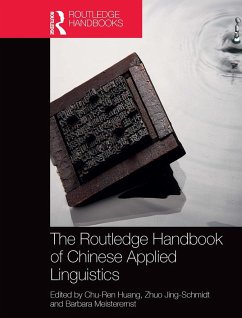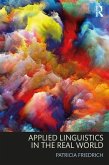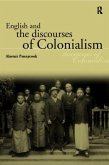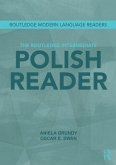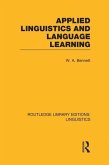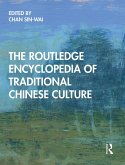The Routledge Handbook of Chinese Applied Linguistics
Herausgeber: Huang, Chu-Ren; Meisterernst, Barbara; Jing-Schmidt, Zhuo
Schade – dieser Artikel ist leider ausverkauft. Sobald wir wissen, ob und wann der Artikel wieder verfügbar ist, informieren wir Sie an dieser Stelle.
The Routledge Handbook of Chinese Applied Linguistics
Herausgeber: Huang, Chu-Ren; Meisterernst, Barbara; Jing-Schmidt, Zhuo
- Broschiertes Buch
- Merkliste
- Auf die Merkliste
- Bewerten Bewerten
- Teilen
- Produkt teilen
- Produkterinnerung
- Produkterinnerung
The Routledge Handbook of Chinese Applied Linguistics is written for those wanting to acquire comprehensive knowledge of China, the diaspora, and the Sino-sphere communities through Chinese language.
Andere Kunden interessierten sich auch für
![Applied Linguistics in the Real World Applied Linguistics in the Real World]() Patricia FriedrichApplied Linguistics in the Real World59,99 €
Patricia FriedrichApplied Linguistics in the Real World59,99 €![English and the Discourses of Colonialism English and the Discourses of Colonialism]() Alastair PennycookEnglish and the Discourses of Colonialism66,99 €
Alastair PennycookEnglish and the Discourses of Colonialism66,99 €![The Student's Handbook of Comparative Grammar Applied to the Sanskrit, Zend, Greek, Latin, Gothic, AngloSaxon and English Languages by Thomas Clark The Student's Handbook of Comparative Grammar Applied to the Sanskrit, Zend, Greek, Latin, Gothic, AngloSaxon and English Languages by Thomas Clark]() Thomas ClarkThe Student's Handbook of Comparative Grammar Applied to the Sanskrit, Zend, Greek, Latin, Gothic, AngloSaxon and English Languages by Thomas Clark25,99 €
Thomas ClarkThe Student's Handbook of Comparative Grammar Applied to the Sanskrit, Zend, Greek, Latin, Gothic, AngloSaxon and English Languages by Thomas Clark25,99 €![The Routledge Intermediate Polish Reader The Routledge Intermediate Polish Reader]() Aniela GrundyThe Routledge Intermediate Polish Reader64,99 €
Aniela GrundyThe Routledge Intermediate Polish Reader64,99 €![Applied Linguistics and Language Learning (RLE Linguistics C Applied Linguistics and Language Learning (RLE Linguistics C]() W. A. BennettApplied Linguistics and Language Learning (RLE Linguistics C63,99 €
W. A. BennettApplied Linguistics and Language Learning (RLE Linguistics C63,99 €![Health Disparities and the Applied Linguist Health Disparities and the Applied Linguist]() Maricel G. SantosHealth Disparities and the Applied Linguist30,99 €
Maricel G. SantosHealth Disparities and the Applied Linguist30,99 €![The Routledge Encyclopedia of Traditional Chinese Culture The Routledge Encyclopedia of Traditional Chinese Culture]() The Routledge Encyclopedia of Traditional Chinese Culture64,99 €
The Routledge Encyclopedia of Traditional Chinese Culture64,99 €-
-
The Routledge Handbook of Chinese Applied Linguistics is written for those wanting to acquire comprehensive knowledge of China, the diaspora, and the Sino-sphere communities through Chinese language.
Produktdetails
- Produktdetails
- Verlag: Taylor & Francis
- Seitenzahl: 810
- Erscheinungstermin: 29. August 2022
- Englisch
- Abmessung: 246mm x 174mm x 43mm
- Gewicht: 1417g
- ISBN-13: 9781032401607
- ISBN-10: 1032401605
- Artikelnr.: 71286803
- Herstellerkennzeichnung
- Libri GmbH
- Europaallee 1
- 36244 Bad Hersfeld
- gpsr@libri.de
- Verlag: Taylor & Francis
- Seitenzahl: 810
- Erscheinungstermin: 29. August 2022
- Englisch
- Abmessung: 246mm x 174mm x 43mm
- Gewicht: 1417g
- ISBN-13: 9781032401607
- ISBN-10: 1032401605
- Artikelnr.: 71286803
- Herstellerkennzeichnung
- Libri GmbH
- Europaallee 1
- 36244 Bad Hersfeld
- gpsr@libri.de
Chu-Ren Huang is Chair Professor at The Hong Kong Polytechnic University, a Fellow of the Hong Kong Academy of the Humanities; and a permanent member of the International Committee on Computational Linguistics. He led the construction of language resources such as CKIP Lexicon, Sinica Corpus, Sinica Treebank, Sinica BOW, Chinese WordNet, and Hantology. His upcoming books include Computational Processing of the Chinese Language, Digital Humanities: Bridging the Divide, and Cambridge Handbook of Chinese Linguistics. Zhuo Jing-Schmidt is Associate Professor at the University of Oregon. She is a broadly trained linguist who researches the interface of language structure, discourse pragmatics, emotion in language, gender and society, and Chinese second language acquisition. Her work transcends traditional disciplinary boundaries and she publishes in three languages - English, Chinese, and German. She is Executive Editor of Chinese Language and Discourse and is on the editorial board of Chinese as a Second Language. Barbara Meisterernst studied Sinology, Germanic Languages and General Linguistics at Münster University, where she received her PhD. She holds a habilitation (second PhD) from Hamburg University. She researched and taught in Paris, Ghent, Berlin and Hamburg. Presently she teaches Historical Chinese Linguistics at National Tsing Hua University, Taiwan.
Introduction Chapter: Language in Action, Language in Context
Chu-Ren Huang (The Hong Kong Polytechnic University) Zhuo Jing-Schmidt
(University of Oregon), and Barbara Meisterernst (National Tsinghua
University)
Language, Culture and Society
Chapter 1. Chinese Philosophy, Religions and Language Friederike Assandri
(University of Leipzig) and Barbara Meisterernst (National Tsinghua
University)
Chapter 2. Chinese Language and Buddhism Jiandao (Luminary Research
Institute, Gaya Foundation), Jianxun (Luminary Research Institute, Gaya
Foundation), and Jiajuan Xiong (South Western University of Finance &
Economics)
Chapter 3. Chinese Language and Christianity Federico Masini (Sapienza
University of Rome)
Chapter 4. Chinese Language and the Silk Roads Barbara Meisterernst
(National Tsinghua University)
Chapter 5. Chinese, Food and Menus Yao Yao (The Hong Kong Polytechnic
University) and Qi Su (Peking University)
Chapter 6. Chinese Language and Fruits Shelley Ching-yu Depner (National
Cheng Kung University)
Chapter 7. Colour Terms in Chinese Huei-ling Lai (National Chengchi
University)
Chapter 8. The Function of Poetic Language and Rhymes in Pre-Modern Chinese
Literature Barbara Meisterernst (National Tsinghua University)
Chapter 9. Chinese Cultures of Learning: Elicited Metaphor Research Lixian
Jin (University of Nottingham Ningbo China) and Martin Cortazzi (University
of Nottingham Ningbo China)
Chapter 10. Learning "Chinese" as a Heritage Language: Challenges, Issues
and Ways Forward Patricia Duff (University of British Columbia) and Liam
Doherty (University of British Columbia)
Chapter 11. Chinese Language and Gender Research Marjorie K.M. Chan (The
Ohio State University) and Yuhan Lin (The Ohio State University)
Chapter 12. Varieties of Chinese: Dialects or Sinitic Languages? Maria
Kurpaska (Adam Mickiewicz University in Poznan)
Chapter 13. Variations in World Chineses Jingxia Lin (Nanyang Technological
University), Dingxu Shi (Guangdong University of Foreign Studies), Menghan
Jiang (The Hong Kong Polytechnic University) and Chu-Ren Huang (The Hong
Kong Polytechnic University)
Chapter 14. Chinese Language and New Immigrants Chin-Chin Tseng (National
Taiwan Normal University) and Chen-Cheng Chun (National Kaohsiung Normal
University)
Chapter 15. Chinese Language and Social Justice Susan D. Blum (University
of Notre Dame)
Language: Expression, Communication and Persuasion
Chapter 16. Chinese Language Arts: The Role of Language and Linguistic
Devices in Literary and Artistic Expressions Chu-Ren Huang (The Hong Kong
Polytechnic University), Kathleen Ahrens (The Hong Kong Polytechnic
University), Tania Becker (Technical University of Berlin), Regina Llamas
(Stanford University), King-fai Tam (The Hong Kong Polytechnic University)
and Barbara Meisterernst (National Tsinghua University)
Chapter 17. Chinese Multimodal Resources for Discourse Act Analysis Alex
Chengyu Fang (City University of Hong Kong), Yanjiao Li (Shandong
University at Weihai), Jing Cao (Zhongnan University of Economics and Law)
and Harry Bunt (Tilburg University)
Chapter 18. Chinese and Counterfactual Reasoning Yan Jiang (SOAS University
of London)
Chapter 19. Linguistic Synaesthesia in Chinese Chu-Ren Huang (The Hong Kong
Polytechnic University) and Jiajuan Xiong (South Western University of
Finance & Economics)
Chapter 20. Chinese and Emotion Analysis Sophia Yat Mei Lee (The Hong Kong
Polytechnic University)
Chapter 21. Humour in Chinese Lingling Ge (University of South China) and
Yuanjian He (University of Macau)
Chapter 22. Irony in Chinese Languages: An Overview and a Case Study I-Wen
Su (National Taiwan University) and Shuping Huang (National Sun Yat-sen
University)
Chapter 23. Metaphor in Chinese Kathleen Ahrens (The Hong Kong Polytechnic
University) and Siaw-Fong Chung (National Chengchi University)
Chapter 24. Commendatory and Derogatory Expressions in Chinese Janet Zhiqun
Xing (Western Washington University)
Chapter 25. Cursing, Taboo and Euphemism Zhuo Jing-Schmidt (University of
Oregon)
Chapter 26. Chinese for Specific Purposes: A Broader Perspective Haidan
Wang and Song Jiang (University of Hawai¿i at Manoa)
Chapter 27. Chinese Translation in the Twenty First Century Weixiao Wei
(Taiyuan University of Technology) and Chris Shei (Swansea University)
Chapter 28. The Study of Chinese Language Advertisements Doreen Wu (The
Hong Kong Polytechnic University) and Chaoyuan Li (Xi'an International
Studies University)
Chapter 29. Chinese Communication in a Globalizing World: An Outline of an
Emerging Contemporary Chinese Discourse Shi-xu (Hangzhou Normal University)
Language, Computer and New Media
Chapter 30. Computer and Chinese Writing System Qin Lu (The Hong Kong
Polytechnic University)
Chapter 31. Digital Language Resources and NLP Tools Chu-Ren Huang (The
Hong Kong Polytechnic University) and Nianwen Xue (Brandeis University)
Chapter 32. Information Quality: Linguistic Cues and Automatic Judgments
Qi Su (Peking University)
Chapter 33. Chinese Neologisms Zhuo Jing-Schmidt (University of Oregon) and
Shu-kai Hsieh (National Taiwan University)
Chapter 34. Online Language Resources: Advances, Applications and
Challenges Weidong Zhan (Peking University), Xiaojing Bai (Tsinghua
University)
Chapter 35. The Impact of Information and Communication Technology on
Chinese Language Life Jingwei Zhang (University of Macau) and Daming Xu
(University of Macau)
Language, Mind and Body
Chapter 36. Chinese and Aphasia Sam-Po Law (The University of Hong Kong)
and Anthony Pak-Hin Kong (University of Central Florida)
Chapter 37. A Study of Syntactic Ability and Its Relation to Theory of Mind
in Cantonese-speaking Children with Autism Spectrum Disorder Mantak Leung
and Honglan Li (The Hong Kong Polytechnic University)
Chapter 38. Language and the Brain in the Sunset Years William S.-Y. Wang
(The Hong Kong Polytechnic University)
Chapter 39. Concept Composition during Language Processing: Two Case
Studies and a Model Maria Mercedes Piñango (Yale University)
Chapter 40. Chinese Reading Acquisition Chia-ying Lee (Academia Sinica)
Chapter 41. Neural Mechanisms for the Processing of Chinese Wei Zhou
(Capital Normal University), Linjun Zhang (Beijing Language and Culture
University), Hua Shu (Beijing Normal University), and Ping Li (Pennsylvania
State University)
Chapter 42. Tone and Music Processing in Chinese Caicai Zhang (The Hong
Kong Polytechnic University)
The Sciences of Language
Chapter 43. Chinese Sociolinguistics Daming Xu (University of Macau)
Jingwei Zhang (University of Macau)
Chapter 44. Linguistic Anthropology of Chinese Chen-chun E (National United
University)
Chapter 45. Chinese Rhetoric Yan Jiang (SOAS University of London)
Chapter 46. Investigating Sign Languages in the Chinese Context Jia Li (The
Chinese University of Hong Kong), Jia He (The Chinese University of Hong
Kong), and Gladys Tang (The Chinese University of Hong Kong)
Chapter 47.Chinese Psycholinguistics: A Typological Overview Chien-Jer
Charles Lin (Indiana University Bloomington)
Chu-Ren Huang (The Hong Kong Polytechnic University) Zhuo Jing-Schmidt
(University of Oregon), and Barbara Meisterernst (National Tsinghua
University)
Language, Culture and Society
Chapter 1. Chinese Philosophy, Religions and Language Friederike Assandri
(University of Leipzig) and Barbara Meisterernst (National Tsinghua
University)
Chapter 2. Chinese Language and Buddhism Jiandao (Luminary Research
Institute, Gaya Foundation), Jianxun (Luminary Research Institute, Gaya
Foundation), and Jiajuan Xiong (South Western University of Finance &
Economics)
Chapter 3. Chinese Language and Christianity Federico Masini (Sapienza
University of Rome)
Chapter 4. Chinese Language and the Silk Roads Barbara Meisterernst
(National Tsinghua University)
Chapter 5. Chinese, Food and Menus Yao Yao (The Hong Kong Polytechnic
University) and Qi Su (Peking University)
Chapter 6. Chinese Language and Fruits Shelley Ching-yu Depner (National
Cheng Kung University)
Chapter 7. Colour Terms in Chinese Huei-ling Lai (National Chengchi
University)
Chapter 8. The Function of Poetic Language and Rhymes in Pre-Modern Chinese
Literature Barbara Meisterernst (National Tsinghua University)
Chapter 9. Chinese Cultures of Learning: Elicited Metaphor Research Lixian
Jin (University of Nottingham Ningbo China) and Martin Cortazzi (University
of Nottingham Ningbo China)
Chapter 10. Learning "Chinese" as a Heritage Language: Challenges, Issues
and Ways Forward Patricia Duff (University of British Columbia) and Liam
Doherty (University of British Columbia)
Chapter 11. Chinese Language and Gender Research Marjorie K.M. Chan (The
Ohio State University) and Yuhan Lin (The Ohio State University)
Chapter 12. Varieties of Chinese: Dialects or Sinitic Languages? Maria
Kurpaska (Adam Mickiewicz University in Poznan)
Chapter 13. Variations in World Chineses Jingxia Lin (Nanyang Technological
University), Dingxu Shi (Guangdong University of Foreign Studies), Menghan
Jiang (The Hong Kong Polytechnic University) and Chu-Ren Huang (The Hong
Kong Polytechnic University)
Chapter 14. Chinese Language and New Immigrants Chin-Chin Tseng (National
Taiwan Normal University) and Chen-Cheng Chun (National Kaohsiung Normal
University)
Chapter 15. Chinese Language and Social Justice Susan D. Blum (University
of Notre Dame)
Language: Expression, Communication and Persuasion
Chapter 16. Chinese Language Arts: The Role of Language and Linguistic
Devices in Literary and Artistic Expressions Chu-Ren Huang (The Hong Kong
Polytechnic University), Kathleen Ahrens (The Hong Kong Polytechnic
University), Tania Becker (Technical University of Berlin), Regina Llamas
(Stanford University), King-fai Tam (The Hong Kong Polytechnic University)
and Barbara Meisterernst (National Tsinghua University)
Chapter 17. Chinese Multimodal Resources for Discourse Act Analysis Alex
Chengyu Fang (City University of Hong Kong), Yanjiao Li (Shandong
University at Weihai), Jing Cao (Zhongnan University of Economics and Law)
and Harry Bunt (Tilburg University)
Chapter 18. Chinese and Counterfactual Reasoning Yan Jiang (SOAS University
of London)
Chapter 19. Linguistic Synaesthesia in Chinese Chu-Ren Huang (The Hong Kong
Polytechnic University) and Jiajuan Xiong (South Western University of
Finance & Economics)
Chapter 20. Chinese and Emotion Analysis Sophia Yat Mei Lee (The Hong Kong
Polytechnic University)
Chapter 21. Humour in Chinese Lingling Ge (University of South China) and
Yuanjian He (University of Macau)
Chapter 22. Irony in Chinese Languages: An Overview and a Case Study I-Wen
Su (National Taiwan University) and Shuping Huang (National Sun Yat-sen
University)
Chapter 23. Metaphor in Chinese Kathleen Ahrens (The Hong Kong Polytechnic
University) and Siaw-Fong Chung (National Chengchi University)
Chapter 24. Commendatory and Derogatory Expressions in Chinese Janet Zhiqun
Xing (Western Washington University)
Chapter 25. Cursing, Taboo and Euphemism Zhuo Jing-Schmidt (University of
Oregon)
Chapter 26. Chinese for Specific Purposes: A Broader Perspective Haidan
Wang and Song Jiang (University of Hawai¿i at Manoa)
Chapter 27. Chinese Translation in the Twenty First Century Weixiao Wei
(Taiyuan University of Technology) and Chris Shei (Swansea University)
Chapter 28. The Study of Chinese Language Advertisements Doreen Wu (The
Hong Kong Polytechnic University) and Chaoyuan Li (Xi'an International
Studies University)
Chapter 29. Chinese Communication in a Globalizing World: An Outline of an
Emerging Contemporary Chinese Discourse Shi-xu (Hangzhou Normal University)
Language, Computer and New Media
Chapter 30. Computer and Chinese Writing System Qin Lu (The Hong Kong
Polytechnic University)
Chapter 31. Digital Language Resources and NLP Tools Chu-Ren Huang (The
Hong Kong Polytechnic University) and Nianwen Xue (Brandeis University)
Chapter 32. Information Quality: Linguistic Cues and Automatic Judgments
Qi Su (Peking University)
Chapter 33. Chinese Neologisms Zhuo Jing-Schmidt (University of Oregon) and
Shu-kai Hsieh (National Taiwan University)
Chapter 34. Online Language Resources: Advances, Applications and
Challenges Weidong Zhan (Peking University), Xiaojing Bai (Tsinghua
University)
Chapter 35. The Impact of Information and Communication Technology on
Chinese Language Life Jingwei Zhang (University of Macau) and Daming Xu
(University of Macau)
Language, Mind and Body
Chapter 36. Chinese and Aphasia Sam-Po Law (The University of Hong Kong)
and Anthony Pak-Hin Kong (University of Central Florida)
Chapter 37. A Study of Syntactic Ability and Its Relation to Theory of Mind
in Cantonese-speaking Children with Autism Spectrum Disorder Mantak Leung
and Honglan Li (The Hong Kong Polytechnic University)
Chapter 38. Language and the Brain in the Sunset Years William S.-Y. Wang
(The Hong Kong Polytechnic University)
Chapter 39. Concept Composition during Language Processing: Two Case
Studies and a Model Maria Mercedes Piñango (Yale University)
Chapter 40. Chinese Reading Acquisition Chia-ying Lee (Academia Sinica)
Chapter 41. Neural Mechanisms for the Processing of Chinese Wei Zhou
(Capital Normal University), Linjun Zhang (Beijing Language and Culture
University), Hua Shu (Beijing Normal University), and Ping Li (Pennsylvania
State University)
Chapter 42. Tone and Music Processing in Chinese Caicai Zhang (The Hong
Kong Polytechnic University)
The Sciences of Language
Chapter 43. Chinese Sociolinguistics Daming Xu (University of Macau)
Jingwei Zhang (University of Macau)
Chapter 44. Linguistic Anthropology of Chinese Chen-chun E (National United
University)
Chapter 45. Chinese Rhetoric Yan Jiang (SOAS University of London)
Chapter 46. Investigating Sign Languages in the Chinese Context Jia Li (The
Chinese University of Hong Kong), Jia He (The Chinese University of Hong
Kong), and Gladys Tang (The Chinese University of Hong Kong)
Chapter 47.Chinese Psycholinguistics: A Typological Overview Chien-Jer
Charles Lin (Indiana University Bloomington)
Introduction Chapter: Language in Action, Language in Context
Chu-Ren Huang (The Hong Kong Polytechnic University) Zhuo Jing-Schmidt
(University of Oregon), and Barbara Meisterernst (National Tsinghua
University)
Language, Culture and Society
Chapter 1. Chinese Philosophy, Religions and Language Friederike Assandri
(University of Leipzig) and Barbara Meisterernst (National Tsinghua
University)
Chapter 2. Chinese Language and Buddhism Jiandao (Luminary Research
Institute, Gaya Foundation), Jianxun (Luminary Research Institute, Gaya
Foundation), and Jiajuan Xiong (South Western University of Finance &
Economics)
Chapter 3. Chinese Language and Christianity Federico Masini (Sapienza
University of Rome)
Chapter 4. Chinese Language and the Silk Roads Barbara Meisterernst
(National Tsinghua University)
Chapter 5. Chinese, Food and Menus Yao Yao (The Hong Kong Polytechnic
University) and Qi Su (Peking University)
Chapter 6. Chinese Language and Fruits Shelley Ching-yu Depner (National
Cheng Kung University)
Chapter 7. Colour Terms in Chinese Huei-ling Lai (National Chengchi
University)
Chapter 8. The Function of Poetic Language and Rhymes in Pre-Modern Chinese
Literature Barbara Meisterernst (National Tsinghua University)
Chapter 9. Chinese Cultures of Learning: Elicited Metaphor Research Lixian
Jin (University of Nottingham Ningbo China) and Martin Cortazzi (University
of Nottingham Ningbo China)
Chapter 10. Learning "Chinese" as a Heritage Language: Challenges, Issues
and Ways Forward Patricia Duff (University of British Columbia) and Liam
Doherty (University of British Columbia)
Chapter 11. Chinese Language and Gender Research Marjorie K.M. Chan (The
Ohio State University) and Yuhan Lin (The Ohio State University)
Chapter 12. Varieties of Chinese: Dialects or Sinitic Languages? Maria
Kurpaska (Adam Mickiewicz University in Poznan)
Chapter 13. Variations in World Chineses Jingxia Lin (Nanyang Technological
University), Dingxu Shi (Guangdong University of Foreign Studies), Menghan
Jiang (The Hong Kong Polytechnic University) and Chu-Ren Huang (The Hong
Kong Polytechnic University)
Chapter 14. Chinese Language and New Immigrants Chin-Chin Tseng (National
Taiwan Normal University) and Chen-Cheng Chun (National Kaohsiung Normal
University)
Chapter 15. Chinese Language and Social Justice Susan D. Blum (University
of Notre Dame)
Language: Expression, Communication and Persuasion
Chapter 16. Chinese Language Arts: The Role of Language and Linguistic
Devices in Literary and Artistic Expressions Chu-Ren Huang (The Hong Kong
Polytechnic University), Kathleen Ahrens (The Hong Kong Polytechnic
University), Tania Becker (Technical University of Berlin), Regina Llamas
(Stanford University), King-fai Tam (The Hong Kong Polytechnic University)
and Barbara Meisterernst (National Tsinghua University)
Chapter 17. Chinese Multimodal Resources for Discourse Act Analysis Alex
Chengyu Fang (City University of Hong Kong), Yanjiao Li (Shandong
University at Weihai), Jing Cao (Zhongnan University of Economics and Law)
and Harry Bunt (Tilburg University)
Chapter 18. Chinese and Counterfactual Reasoning Yan Jiang (SOAS University
of London)
Chapter 19. Linguistic Synaesthesia in Chinese Chu-Ren Huang (The Hong Kong
Polytechnic University) and Jiajuan Xiong (South Western University of
Finance & Economics)
Chapter 20. Chinese and Emotion Analysis Sophia Yat Mei Lee (The Hong Kong
Polytechnic University)
Chapter 21. Humour in Chinese Lingling Ge (University of South China) and
Yuanjian He (University of Macau)
Chapter 22. Irony in Chinese Languages: An Overview and a Case Study I-Wen
Su (National Taiwan University) and Shuping Huang (National Sun Yat-sen
University)
Chapter 23. Metaphor in Chinese Kathleen Ahrens (The Hong Kong Polytechnic
University) and Siaw-Fong Chung (National Chengchi University)
Chapter 24. Commendatory and Derogatory Expressions in Chinese Janet Zhiqun
Xing (Western Washington University)
Chapter 25. Cursing, Taboo and Euphemism Zhuo Jing-Schmidt (University of
Oregon)
Chapter 26. Chinese for Specific Purposes: A Broader Perspective Haidan
Wang and Song Jiang (University of Hawai¿i at Manoa)
Chapter 27. Chinese Translation in the Twenty First Century Weixiao Wei
(Taiyuan University of Technology) and Chris Shei (Swansea University)
Chapter 28. The Study of Chinese Language Advertisements Doreen Wu (The
Hong Kong Polytechnic University) and Chaoyuan Li (Xi'an International
Studies University)
Chapter 29. Chinese Communication in a Globalizing World: An Outline of an
Emerging Contemporary Chinese Discourse Shi-xu (Hangzhou Normal University)
Language, Computer and New Media
Chapter 30. Computer and Chinese Writing System Qin Lu (The Hong Kong
Polytechnic University)
Chapter 31. Digital Language Resources and NLP Tools Chu-Ren Huang (The
Hong Kong Polytechnic University) and Nianwen Xue (Brandeis University)
Chapter 32. Information Quality: Linguistic Cues and Automatic Judgments
Qi Su (Peking University)
Chapter 33. Chinese Neologisms Zhuo Jing-Schmidt (University of Oregon) and
Shu-kai Hsieh (National Taiwan University)
Chapter 34. Online Language Resources: Advances, Applications and
Challenges Weidong Zhan (Peking University), Xiaojing Bai (Tsinghua
University)
Chapter 35. The Impact of Information and Communication Technology on
Chinese Language Life Jingwei Zhang (University of Macau) and Daming Xu
(University of Macau)
Language, Mind and Body
Chapter 36. Chinese and Aphasia Sam-Po Law (The University of Hong Kong)
and Anthony Pak-Hin Kong (University of Central Florida)
Chapter 37. A Study of Syntactic Ability and Its Relation to Theory of Mind
in Cantonese-speaking Children with Autism Spectrum Disorder Mantak Leung
and Honglan Li (The Hong Kong Polytechnic University)
Chapter 38. Language and the Brain in the Sunset Years William S.-Y. Wang
(The Hong Kong Polytechnic University)
Chapter 39. Concept Composition during Language Processing: Two Case
Studies and a Model Maria Mercedes Piñango (Yale University)
Chapter 40. Chinese Reading Acquisition Chia-ying Lee (Academia Sinica)
Chapter 41. Neural Mechanisms for the Processing of Chinese Wei Zhou
(Capital Normal University), Linjun Zhang (Beijing Language and Culture
University), Hua Shu (Beijing Normal University), and Ping Li (Pennsylvania
State University)
Chapter 42. Tone and Music Processing in Chinese Caicai Zhang (The Hong
Kong Polytechnic University)
The Sciences of Language
Chapter 43. Chinese Sociolinguistics Daming Xu (University of Macau)
Jingwei Zhang (University of Macau)
Chapter 44. Linguistic Anthropology of Chinese Chen-chun E (National United
University)
Chapter 45. Chinese Rhetoric Yan Jiang (SOAS University of London)
Chapter 46. Investigating Sign Languages in the Chinese Context Jia Li (The
Chinese University of Hong Kong), Jia He (The Chinese University of Hong
Kong), and Gladys Tang (The Chinese University of Hong Kong)
Chapter 47.Chinese Psycholinguistics: A Typological Overview Chien-Jer
Charles Lin (Indiana University Bloomington)
Chu-Ren Huang (The Hong Kong Polytechnic University) Zhuo Jing-Schmidt
(University of Oregon), and Barbara Meisterernst (National Tsinghua
University)
Language, Culture and Society
Chapter 1. Chinese Philosophy, Religions and Language Friederike Assandri
(University of Leipzig) and Barbara Meisterernst (National Tsinghua
University)
Chapter 2. Chinese Language and Buddhism Jiandao (Luminary Research
Institute, Gaya Foundation), Jianxun (Luminary Research Institute, Gaya
Foundation), and Jiajuan Xiong (South Western University of Finance &
Economics)
Chapter 3. Chinese Language and Christianity Federico Masini (Sapienza
University of Rome)
Chapter 4. Chinese Language and the Silk Roads Barbara Meisterernst
(National Tsinghua University)
Chapter 5. Chinese, Food and Menus Yao Yao (The Hong Kong Polytechnic
University) and Qi Su (Peking University)
Chapter 6. Chinese Language and Fruits Shelley Ching-yu Depner (National
Cheng Kung University)
Chapter 7. Colour Terms in Chinese Huei-ling Lai (National Chengchi
University)
Chapter 8. The Function of Poetic Language and Rhymes in Pre-Modern Chinese
Literature Barbara Meisterernst (National Tsinghua University)
Chapter 9. Chinese Cultures of Learning: Elicited Metaphor Research Lixian
Jin (University of Nottingham Ningbo China) and Martin Cortazzi (University
of Nottingham Ningbo China)
Chapter 10. Learning "Chinese" as a Heritage Language: Challenges, Issues
and Ways Forward Patricia Duff (University of British Columbia) and Liam
Doherty (University of British Columbia)
Chapter 11. Chinese Language and Gender Research Marjorie K.M. Chan (The
Ohio State University) and Yuhan Lin (The Ohio State University)
Chapter 12. Varieties of Chinese: Dialects or Sinitic Languages? Maria
Kurpaska (Adam Mickiewicz University in Poznan)
Chapter 13. Variations in World Chineses Jingxia Lin (Nanyang Technological
University), Dingxu Shi (Guangdong University of Foreign Studies), Menghan
Jiang (The Hong Kong Polytechnic University) and Chu-Ren Huang (The Hong
Kong Polytechnic University)
Chapter 14. Chinese Language and New Immigrants Chin-Chin Tseng (National
Taiwan Normal University) and Chen-Cheng Chun (National Kaohsiung Normal
University)
Chapter 15. Chinese Language and Social Justice Susan D. Blum (University
of Notre Dame)
Language: Expression, Communication and Persuasion
Chapter 16. Chinese Language Arts: The Role of Language and Linguistic
Devices in Literary and Artistic Expressions Chu-Ren Huang (The Hong Kong
Polytechnic University), Kathleen Ahrens (The Hong Kong Polytechnic
University), Tania Becker (Technical University of Berlin), Regina Llamas
(Stanford University), King-fai Tam (The Hong Kong Polytechnic University)
and Barbara Meisterernst (National Tsinghua University)
Chapter 17. Chinese Multimodal Resources for Discourse Act Analysis Alex
Chengyu Fang (City University of Hong Kong), Yanjiao Li (Shandong
University at Weihai), Jing Cao (Zhongnan University of Economics and Law)
and Harry Bunt (Tilburg University)
Chapter 18. Chinese and Counterfactual Reasoning Yan Jiang (SOAS University
of London)
Chapter 19. Linguistic Synaesthesia in Chinese Chu-Ren Huang (The Hong Kong
Polytechnic University) and Jiajuan Xiong (South Western University of
Finance & Economics)
Chapter 20. Chinese and Emotion Analysis Sophia Yat Mei Lee (The Hong Kong
Polytechnic University)
Chapter 21. Humour in Chinese Lingling Ge (University of South China) and
Yuanjian He (University of Macau)
Chapter 22. Irony in Chinese Languages: An Overview and a Case Study I-Wen
Su (National Taiwan University) and Shuping Huang (National Sun Yat-sen
University)
Chapter 23. Metaphor in Chinese Kathleen Ahrens (The Hong Kong Polytechnic
University) and Siaw-Fong Chung (National Chengchi University)
Chapter 24. Commendatory and Derogatory Expressions in Chinese Janet Zhiqun
Xing (Western Washington University)
Chapter 25. Cursing, Taboo and Euphemism Zhuo Jing-Schmidt (University of
Oregon)
Chapter 26. Chinese for Specific Purposes: A Broader Perspective Haidan
Wang and Song Jiang (University of Hawai¿i at Manoa)
Chapter 27. Chinese Translation in the Twenty First Century Weixiao Wei
(Taiyuan University of Technology) and Chris Shei (Swansea University)
Chapter 28. The Study of Chinese Language Advertisements Doreen Wu (The
Hong Kong Polytechnic University) and Chaoyuan Li (Xi'an International
Studies University)
Chapter 29. Chinese Communication in a Globalizing World: An Outline of an
Emerging Contemporary Chinese Discourse Shi-xu (Hangzhou Normal University)
Language, Computer and New Media
Chapter 30. Computer and Chinese Writing System Qin Lu (The Hong Kong
Polytechnic University)
Chapter 31. Digital Language Resources and NLP Tools Chu-Ren Huang (The
Hong Kong Polytechnic University) and Nianwen Xue (Brandeis University)
Chapter 32. Information Quality: Linguistic Cues and Automatic Judgments
Qi Su (Peking University)
Chapter 33. Chinese Neologisms Zhuo Jing-Schmidt (University of Oregon) and
Shu-kai Hsieh (National Taiwan University)
Chapter 34. Online Language Resources: Advances, Applications and
Challenges Weidong Zhan (Peking University), Xiaojing Bai (Tsinghua
University)
Chapter 35. The Impact of Information and Communication Technology on
Chinese Language Life Jingwei Zhang (University of Macau) and Daming Xu
(University of Macau)
Language, Mind and Body
Chapter 36. Chinese and Aphasia Sam-Po Law (The University of Hong Kong)
and Anthony Pak-Hin Kong (University of Central Florida)
Chapter 37. A Study of Syntactic Ability and Its Relation to Theory of Mind
in Cantonese-speaking Children with Autism Spectrum Disorder Mantak Leung
and Honglan Li (The Hong Kong Polytechnic University)
Chapter 38. Language and the Brain in the Sunset Years William S.-Y. Wang
(The Hong Kong Polytechnic University)
Chapter 39. Concept Composition during Language Processing: Two Case
Studies and a Model Maria Mercedes Piñango (Yale University)
Chapter 40. Chinese Reading Acquisition Chia-ying Lee (Academia Sinica)
Chapter 41. Neural Mechanisms for the Processing of Chinese Wei Zhou
(Capital Normal University), Linjun Zhang (Beijing Language and Culture
University), Hua Shu (Beijing Normal University), and Ping Li (Pennsylvania
State University)
Chapter 42. Tone and Music Processing in Chinese Caicai Zhang (The Hong
Kong Polytechnic University)
The Sciences of Language
Chapter 43. Chinese Sociolinguistics Daming Xu (University of Macau)
Jingwei Zhang (University of Macau)
Chapter 44. Linguistic Anthropology of Chinese Chen-chun E (National United
University)
Chapter 45. Chinese Rhetoric Yan Jiang (SOAS University of London)
Chapter 46. Investigating Sign Languages in the Chinese Context Jia Li (The
Chinese University of Hong Kong), Jia He (The Chinese University of Hong
Kong), and Gladys Tang (The Chinese University of Hong Kong)
Chapter 47.Chinese Psycholinguistics: A Typological Overview Chien-Jer
Charles Lin (Indiana University Bloomington)

